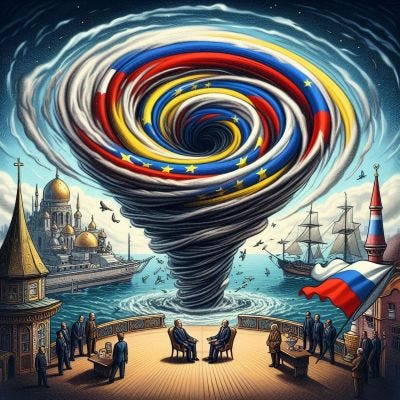News of the spectacular “spiderweb” mass drone attack on Russian air bases on June 1 will have been uppermost in the minds of delegates who assembled the following day for another round of direct talks between Russia and Ukraine in Istanbul.
The attack appears to have been a triumph of Ukrainian intelligence and planning that destroyed or damaged billions of pounds’ worth of Russian aircraft stationed at bases across the country, including at locations as far away as Siberia.
Ukraine’s drone strikes, much like Russia’s intensifying air campaign, hardly signal either side’s sincere commitment to negotiations. As it turned out, little of any consequence was agreed at the brief meeting between negotiators, beyond a prisoner swap, confirming yet again that neither a ceasefire nor a peace agreement are likely anytime soon.
As with the similarly inconclusive meeting between the two sides on May 16, the lack of progress is unsurprising.
However, the broader context of developments on the battlefield and beyond offers important clues about the trajectory of the war in the coming months.
At their earlier meeting in Istanbul in May, Moscow and Kyiv had agreed to draft and exchange detailed proposals for a settlement. The Ukrainian proposal reiterated the long-standing position of Kyiv and its western allies that concessions on the sovereignty and territorial integrity of the country are unacceptable.
In other words, a Russian-imposed neutrality ruling out NATO membership and limiting the size of Ukraine’s armed forces as well as any international recognition of Moscow’s illegal land-grabs since the annexation of Crimea in 2014 are non-starters for Ukraine. While the Ukrainian proposal accepts a ceasefire along the frontline, it considers this only as “the starting point for negotiations” and demands that “territory issues are discussed only after a full and unconditional ceasefire.”
In substance, this is very similar to Zelensky’s peace plan of late 2022 which failed to get broader traction outside the capitals of Ukraine’s western allies.
The Russian proposals are also mostly old news. Moscow’s terms were only handed to Ukrainian negotiators at their meeting in Istanbul on Monday. Given what the Kremlin is reported to be asking for, this is unlikely to have made any difference to the possibility of meaningful discussions between the sides: the full recognition of Russian territorial claims since 2014, Ukrainian neutrality, and the stringent conditions set out for even a temporary ceasefire are hardly in any way more serious negotiation positions from Ukraine’s perspective than Kyiv’s proposals are likely to be to Moscow. In fact, what the Kremlin put on the table in Istanbul is more akin to surrender terms.
Ukraine is in no mood or need to surrender.
The wave of drone attacks targeted several airbases deep inside Russia on June 1, including some hosting parts of Russia’s strategic bomber fleet. But this, like previous drone strikes against Moscow in June 2023, is more of a symbolic morale booster than signalling a sustainable Ukrainian capability that could prove critical in evening out some of the advantages that Russia has over Ukraine in terms of material mass and manpower.
Closer to the frontlines inside Ukraine, Kyiv’s forces also struck the power grid inside the Russian-occupied parts of Zaporizhzhia and Kherson regions. This may have an impact on any Russian plans for an offensive to capture more of these two southern Ukrainian regions that Russia has claimed since sham referendums in September 2022 but still does not fully control. But much like the drone strikes deep into Russia, it is, at best, an operation that entrenches, rather than breaks the current stalemate.
There is no doubt that Ukraine remains under severe military pressure from Russia along most of the more than 1,000km-long frontline. The country is also still very vulnerable to Russian air attacks. However, while Russia might continue to make incremental gains on the battlefield, a game-changing Russian offensive or a collapse of Ukrainian defences does not appear to be on the cards.
Kyiv’s position will potentially also be strengthened by a new bill in the US senate that threatens the imposition of 500% tariffs on any countries that buy Russian resources. This would primarily affect India and China, the largest consumers of Russian oil and gas and could cut Russia off from critical revenues and imports — if New Delhi and Beijing decide that trade with the US is more important to them than cheap imports from Russia.
Yet, US president Donald Trump, to date has been indecisive when it comes to putting any real, rather than just rhetorical pressure on his Russian counterpart, Vladimir Putin. It is, therefore, not clear whether the proposed senate bill will have the desired effect any time soon or at all.
By contrast, European support for Ukraine has, if anything, increased over the past months. It still falls short of Kyiv would require for a major shift in the balance of power on the battlefield, but it remains enough, for now, to prevent Russia from becoming militarily so dominant that Moscow’s current settlement proposals would present the only option for at least some part of Ukraine to survive as an independent state.
The war against Ukraine remains in a stalemate. Neither Moscow nor Kyiv appear to have the capacity to escalate their military efforts to the degree necessary that would force the other side to make substantial concessions.
Both sides are playing for time in the hope that their fortunes may change in the foreseeable future. For Ukraine, this would mean more US military support for Zelensky and more sanctions pressure on Putin, while Europe follows through on building up its own and Ukraine’s defence capabilities.
The Russian calculations will be different. Putin will need to keep his few remaining allies — China, Iran and North Korea — on side while trying to make a deal with Trump. This may be impossible to achieve, and the Russian dictator’s best hope might be that Trump does not impose any serious sanctions on Russia or its trade partners, let alone lean into increasing military support for Ukraine.
For both sides, a lot still hinges on Washington. The unpredictability of the Trump White House, much like the self-imposed restraint under Biden, makes it unlikely that the war in Ukraine moves beyond the current stalemate. What’s more, US policies have now become a major, and perhaps the decisive roadblock on the path to a just and sustainable peace because they enable both Moscow and Kyiv to dream of victory in a war that has become unwinnable.
An earlier version of this analysis was published by The Conversation on June 3, 2025.
We hope you'll share Navigating the Vortex with anyone you think might find it of interest. Also, you can listen to our podcast editions via the website and on all major podcast platforms, including:












